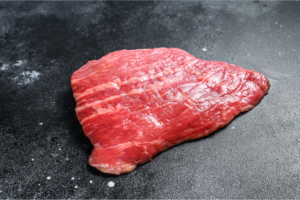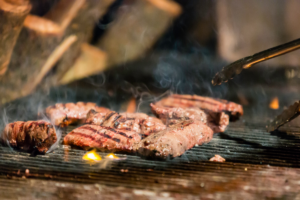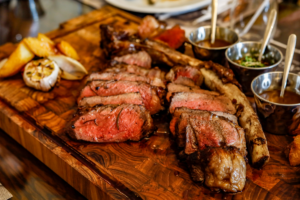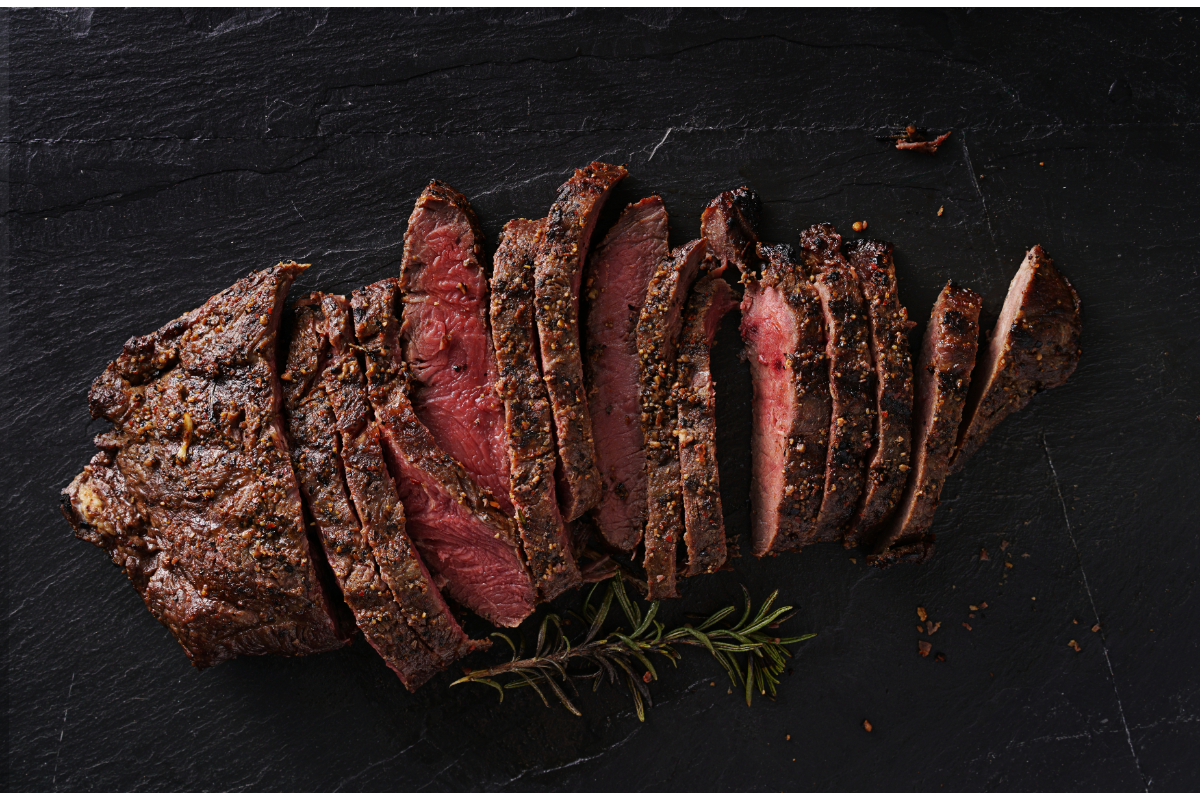Flat Iron Steak, a culinary gem, offers a world of flavors and textures, making it a favorite among steak enthusiasts. This comprehensive guide delves into every aspect of Flat Iron Steak, from selecting the best cut to mastering various cooking techniques. Whether you’re a seasoned chef or a home cook, this article promises to elevate your steak game, ensuring every bite is as delectable as it is memorable.
1.1 What is Flat Iron Steak?
Flat Iron Steak, a relatively new addition to the steak family, is quickly becoming a go-to choice for meat lovers. Originating from the shoulder of the cow, this cut is known for its rich flavor and tender texture. Unlike more traditional cuts like ribeye or sirloin, Flat Iron boasts a unique combination of tenderness and beefy taste, making it a standout choice for a variety of dishes.
1.2 Popularity and Culinary Significance
The rise in popularity of Flat Iron Steak is no fluke. Chefs and home cooks alike are discovering the versatility and robust flavor profile of this cut. It’s not just about the taste; the Flat Iron Steak also offers great value, making it a fantastic option for those who want to enjoy a luxurious steak experience without breaking the bank. Its culinary significance lies in its ability to adapt to different cooking methods while maintaining its inherent qualities – a true testament to its growing fame in the culinary world.
2. Selecting the Best Flat Iron Steak

2.1 Choosing the Right Cut
When it comes to Flat Iron Steak, picking the right cut is crucial. You’re looking for a steak that’s marbled with fat, as this is where that delectable flavor and juiciness come from. The color of the steak should be a vibrant red, indicating freshness and quality. Don’t shy away from asking your butcher for advice; they’re the experts and can guide you to the best cuts available.
2.2 Where to Buy Flat Iron Steak
Flat Iron Steak can be found in most supermarkets, but for the best quality, consider visiting a specialty butcher shop. These shops often source higher-grade meats and can provide cuts that are tailored to your cooking needs. For a deeper understanding of beef cuts and their qualities, the American Meat Science Association offers valuable insights that can enhance your selection process.
2.3 Characteristics of a Quality Cut
A quality Flat Iron Steak should have a good balance of meat and fat. The fat should be white or cream-colored, which is a sign of a well-fed animal. The steak should also be consistent in thickness to ensure even cooking. Remember, the quality of your steak significantly influences the final dish, so choose wisely!
3. Preparation Techniques

3.1 Preparing Your Steak for Cooking
Before you even think about turning on the stove, proper preparation of your Flat Iron Steak is key. This begins with bringing your steak to room temperature, ensuring it cooks evenly. Pat the steak dry with paper towels to remove any excess moisture, which helps in achieving a perfect sear.
3.2 Cleaning and Drying
Start by gently rinsing your steak under cold water. This step is crucial for removing any residual blood or bone fragments. After rinsing, pat the steak dry thoroughly. Excess moisture on the steak’s surface can steam the meat instead of searing it, so this step is vital for that coveted crust.
3.3 To Marinate or Not?
Flat Iron Steak is naturally tender and flavorful, so a heavy marinade isn’t always necessary. However, if you choose to marinate, keep it simple. A blend of olive oil, garlic, and herbs can enhance the steak’s natural flavors without overpowering them. For marinating ideas and techniques, Food & Wine Magazine provides a plethora of options to suit any palate.
3.4 Seasoning Tips
When it comes to seasoning, less is often more with Flat Iron Steak. A generous sprinkle of kosher salt and freshly ground black pepper is usually enough to complement its natural flavors. If you’re feeling adventurous, a touch of smoked paprika or a hint of garlic powder can add an extra dimension to the steak.
With your steak prepped and ready, it’s time to move on to the cooking methods that will transform it into a culinary delight.
4. What is Flat Iron Steak Good For ?

Flat Iron Steak, with its rich flavor and tender texture, is incredibly versatile, making it suitable for a wide range of dishes. Whether you’re grilling, pan-frying, or incorporating it into more elaborate recipes, this cut adapts beautifully, providing a gourmet experience in various culinary contexts.
4.1 Grilling for Flavor
Grilling Flat Iron Steak brings out its robust beefy flavor. The high heat of the grill chars the exterior, creating a delicious crust while keeping the inside juicy and tender. It’s perfect for barbecues and outdoor cooking events, where its flavor can truly shine.
4.2 Pan-Frying Techniques
Pan-frying is another excellent method for cooking Flat Iron Steak. It allows for precise control of the cooking temperature, ensuring that the steak is cooked to your preferred level of doneness. A cast-iron skillet is ideal for this method, as it retains heat well and helps in achieving an even sear.
4.3 Broiling – An Alternative Approach
Broiling is a less common but equally effective way to cook Flat Iron Steak. It involves cooking the steak under high heat in the oven, which is great for achieving a crust similar to grilling but with the convenience of indoor cooking. For tips on perfecting the broiling method, Serious Eats offers expert advice and techniques.
4.4 Incorporating into Recipes
Flat Iron Steak isn’t just for grilling or frying; it’s also fantastic in various recipes. Its tender texture makes it ideal for slicing thin and adding to salads, sandwiches, and wraps. It can also be cubed for stews or stir-fries, where it adds substantial flavor and richness to the dish.
5. What’s the best way to cook a flat iron steak ?
5.1 Expert Tips for Perfect Steak
Cooking the perfect Flat Iron Steak is an art form, and with a few expert tips, you can elevate your steak from good to extraordinary. It’s all about understanding the nuances of cooking and how to bring out the best in this particular cut.
5.2 Temperature and Timing
The key to a succulent Flat Iron Steak lies in the cooking temperature and timing. For medium-rare, aim for an internal temperature of around 130-135°F. It’s essential to use a meat thermometer to ensure accuracy. Overcooking can lead to a tough and less flavorful steak. For more detailed guidelines on cooking temperatures for different levels of doneness, the American Meat Science Association provides comprehensive resources.
5.3 Achieving the Perfect Sear
A great sear not only adds flavor but also locks in the juices. To achieve this, make sure your pan or grill is hot before adding the steak. This high heat creates a Maillard reaction, giving the steak a flavorful crust. Remember, don’t move the steak around too much while it’s cooking; let it sear undisturbed for a few minutes on each side.
5.4 Resting Your Steak
Once cooked, it’s crucial to let your steak rest for about 5-10 minutes before slicing. This allows the juices to redistribute throughout the meat, ensuring every bite is juicy and flavorful. Cover the steak loosely with foil during this time to keep it warm.
With these advanced cooking tips, your Flat Iron Steak is sure to be a hit. Next, we’ll explore how to serve your perfectly cooked steak, along with some delicious pairing suggestions.
Conclusion
In conclusion, Flat Iron Steak is a culinary treasure that offers versatility, rich flavor, and tender texture. From selecting the right cut to mastering various cooking techniques, this guide has walked you through each step of creating a mouth-watering steak dish. Whether you’re grilling, pan-frying, or broiling, the key is to respect the steak’s natural qualities and enhance them with your cooking skills. Remember, the perfect steak is not just about the cooking method; it’s about the care and attention you put into each stage of preparation and cooking. So, the next time you’re in the mood for a steak, consider the Flat Iron cut and use these tips to create a meal that’s not just satisfying but truly memorable. Bon appétit!
For more culinary adventures, explore the French Apple Cake: A Classic Recipe with a Modern Twist, which pairs wonderfully with the robust flavors of Flat Iron Steak. Or, if you’re looking for something different, try the Blackstone Chicken Fried Rice, a delightful dish that offers a unique twist on a classic favorite.

